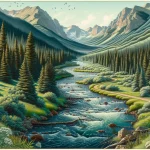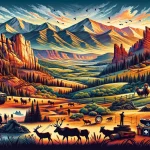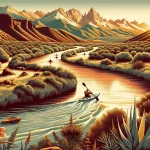Stretching 152 miles from Leadville to the Royal Gorge and merging with the Mississippi River, the Arkansas River provides stunning scenery, exciting whitewater rafting, world-class fishing, diverse wildlife, and a rich history of the United States.
In This Article
Whether you’re looking for an adrenaline-pumping rafting trip through Class V rapids, a scenic drive admiring colorful fall foliage, or a peaceful afternoon fly fishing with a chance to spot ospreys and blue herons, you’ll find endless opportunities along the banks of the Arkansas River. The river also holds great environmental significance, with ongoing efforts to monitor water quality and restore delicate habitats.
As you explore this magnificent ribbon of water, you’ll discover charming mountain towns, soak in natural hot springs, and gain insight into the region’s mining and railroad heritage. From families looking for a memorable vacation to hardcore paddlers seeking their next challenge, the Arkansas River has something special to offer every outdoor enthusiast.
TL;DR
- The Arkansas River in central Colorado offers 152 miles of recreation, including whitewater rafting, fishing, hiking, wildlife viewing, and more.
- The river valley provides stunning Rocky Mountain scenery and access to charming towns like Salida, Little Rock, and Canon City.
- Ongoing conservation efforts aim to protect the water quality, delicate habitats, and diversity of plants and wildlife in the United States.
- Whether traveling with family or seeking hardcore adventure, the diversity of activities and rich natural beauty allows visitors to craft their perfect Colorado vacation.
Local Experiences and Culture
As you explore the Arkansas River or Mississippi River, take time to immerse yourself in local culture and savor authentic Arkansas river trail experiences.
In Salida, stroll through galleries and museums highlighting regional art, mining, and railroad history before sampling farm-to-table cuisine made from fresh, seasonal ingredients. Don’t miss the famous Thursday night concert series in Riverside Park, where bluegrass and folk musicians entertain lively crowds. The local community is passionate about preserving Salida’s creative spirit and historic charm.
Downstream in Canon City, ride the Royal Gorge Route Railroad for panoramic views of the Arkansas River, winding through the great plain and steep granite walls of the Royal Gorge. This two-hour trip back in time features entertaining narration about the railroad, mining, and pioneer history that shaped the region. Cap off your cultural immersion with a stop at one of the town’s four brewpubs or wineries, where you can toast to your Arkansas River adventures.
The downtown River Market District in Little Rock is another wonderful destination. The Little Rock district in Arkansas offers a blend of historical significance and modern charm. A great place to start is with the Central High School National Historic Site, commemorating the Civil Rights Movement. Then, explore the River Market District for eclectic dining and shopping experiences. Additionally, enjoy outdoor activities along the Arkansas River Trail or delve into cultural attractions like the Arkansas Arts Center.
Adventure and Outdoor Activities
As one of the most popular whitewater rafting destinations in the country, the Arkansas River serves up fun and adventure for paddlers of all abilities. Beginners can enjoy scenic float trips near Salida and the Royal Gorge while experts test their skills on Class IV and V rapids with names like Widowmaker and Sledgehammer.
To stay safe while rafting, always wear a helmet and life jacket provided by licensed outfitters. Their expert guides will review paddling basics, teach you how to navigate rapids, and ensure proper precautions are taken. Rafting is typically best between May and September when snowmelt produces thrilling flows.
Beyond heart-pounding whitewater, the Arkansas River also lures anglers with outstanding trout fishing. Find secluded holes harboring healthy rainbow, brown, and cutthroat trout. Time your visit for March and April when hatches spur feeding activity. Remember to acquire a Colorado fishing license and review the limits with the fishing report.
The river also provides a gateway to hiking and biking trails, delivering panoramic views, while the Phantom Canyon area offers opportunities for climbing, ziplining, and more. Rafting trips are another excursion, perfect for thrill-seeking adventures. Whether you seek an adrenaline rush or a peaceful connection with nature, the Arkansas River has an adventure for you.
Environmental and Conservation Efforts
As a life-giving resource for plants, animals and human communities, maintaining the ecological health of the Arkansas River is a top priority. Careful monitoring ensures acceptable water quality for drinking, agriculture, and recreation. The river’s flow is also meticulously controlled through dams and reservoirs to prevent flooding while supporting native fish and riparian habitats.
One critical initiative is the Upper Arkansas River Habitat Restoration project, which aims to improve fish sustainability and angling opportunities. Strategies include adding woody debris to enhance shelter and spawning sites, narrowing channels to increase depth, and stabilizing eroded banks with native vegetation.
You can support conservation efforts by respecting fishing regulations, staying on designated trails, and properly disposing of waste. But most importantly, spread the word about programs safeguarding the Arkansas River’s future. Preserving this precious watershed will allow generations to enjoy its beauty.
Fishing and Wildlife
Anglers flock to the Gold Medal Waters of the Arkansas tailwater for outstanding trout fishing sustained by consistent cold flows released from upstream dams. The river teems with a variety of fish, including sizable catfish, rainbow and brown trout, and feisty populations of mountain whitefish.
Focus your casting for fish along eddies, riffles, and pools located from Salida downstream through the Royal Gorge. You’ll often spot anglers wading mid-channel or navigating the river by boat. Local shops can provide insider tips on secret honey holes and the best flies and lures for different times of year.
While reeling in trout, keep an eye out for soaring ospreys, great blue herons stalking the shallows, and busy beavers tending their lodges along the banks. At dusk, you may spot mule deer and elk visiting the water’s edge. Majestic bighorn sheep are also found navigating steep hillsides with remarkable agility. With diverse fish and wildlife, a quiet afternoon along the Arkansas delivers exciting natural encounters.
Historical and Cultural Sites
From prehistoric peoples to early explorers, fur trappers, miners, railroad workers, and pioneers, the Arkansas River has been a major travel corridor and life-giving resource for thousands of years. Numerous historical sites document its storied past.
In Leadville, visit the Healy House and Dexter Cabin to learn about 19th-century pioneers who settled in Colorado’s highest incorporated city. Further downstream, the Vapor Caves protected prehistoric peoples and railroad workers blasting the Royal Gorge. Canon City’s Museum of Colorado Prisons presents intriguing exhibits on the area’s unusual concentration of correctional facilities.
Historically, Fort Smith was a trading post and military outpost during the 19th century. Fort Smith served as a hub for transportation and commerce along the fiver, facilitating trade and communication between Native American tribes and military personnel. The riverfront area of For Smith has been revitalized with parks, trails, and attractions.
Brown’s Canyon is a renowned section of the river, located near Buena Vista, Colorado. It is famous for its thrilling whitewater rapids and stunning scenery, making it one of the more popular whitewater rafting destinations in the United States. As it flows through Brown’s Canyon, it carves its way through suggest granite canyons, creating exhilarating rapids and breathtaking vistas of the Rocky Mountains.
For a unique perspective on the Arkansas River, take an underground tour of the Williams Canyon dinosaur tracks to examine 110-million-year-old footprints preserved in stone. As past eras come alive, you gain insight into the Arkansas River valley’s exceptional human and natural history.
Recreational Activities
Whether traveling solo or with a group, families, or thrill-seekers, people of all ages find endless recreational opportunities along the banks of Arkansas. Escape the summer heat by pitching a tent beneath shady cottonwoods and stately pines in one of 10 riverfront campgrounds. Wake to spectacular sunrises before hitting the water for a guided rafting trip. At day’s end, enjoy tasty grilled fare while swapping stories around the campfire.
If camping isn’t your style, lodging options like riverside cabins, cottages, and motels provide home bases for adventure. Ideal for families, the Arkansas Headwaters Recreation Area (AHRA) offers activities from ranger talks to junior ranger programs. Extensive hiking and biking trails also deliver stunning vistas, waterfall views, and chances to spot wildlife. For a scenic drive allowing frequent river overlooks, follow Highway 50. You’ll find inspiration around every bend.
The AHRA is a stunning stretch of the Arkansas River, spanning 152 miles from Leadville to Pueblo in Colorado. The area is characterized by towering peaks, rugged canyons, and scenic landscapes, attracting outdoor enthusiasts around the world.
Monitoring and Research
An intricate network of stream gauges, along with regular water quality testing, allows scientists and land managers to closely monitor conditions and trends impacting both the Arkansas River and the Mississippi River. This data informs decisions on reservoir operations, habitat restoration plans, and recreational access.
During extreme rain events like the deadly Pueblo Flood of 1921, monitoring provides early warning, allowing downstream communities to activate emergency plans. Measurements of sediment transport and bank erosion also help identify locations needing stabilization or rechanneling to prevent future flooding.
Ongoing analysis of heavy metal concentrations ensures irrigation and drinking water safety while documenting the river’s natural ability to transform dissolved metals into inert forms. Researchers can even pinpoint pollution sources using isotopic fingerprints. From informing water policy to revealing geological mysteries, scientific monitoring safeguards both the Arkansas River’s and the United States’ future.
FAQ
How do I plan a whitewater rafting trip along the Arkansas River?
Connect with a licensed outfitter like Arkansas Valley Adventures or Echo Canyon River Expeditions to book a guided full or half-day rafting trip. They’ll provide all necessary equipment, orientation on safety and paddling, and shuttle services to and from the river. Rafting is suitable for ages five and up.
What is the best way to fish the Arkansas River?
The most effective technique is fly fishing along the edges of swift runs and deeper pools. You’ll need a valid Colorado fishing license and should target rainbow and brown trout. Hire an experienced fishing guide for a full day on the river to access prime spots and receive pro tips.
Where are the best places to go camping along the Arkansas River?
Popular campgrounds like Hecla Junction, Clear Creek, and Sego Springs offer tent and RV sites steps from the river. Reservations are recommended. Many whitewater rafting packages also include riverside camping as part of a multi-day trip.
What is there to do in the winter along the Arkansas River?
Once summer crowds dissipate, enjoy peaceful hikes and bike rides with stunning snow-capped views. You can also book ice climbing adventures, snowshoes to hidden hot springs, and even try your hand at river surfing on stand-up paddleboards!
How accessible is the Arkansas River for visitors with disabilities?
Many rafting companies offer adaptive trips with trained guides and equipment to accommodate both physical and cognitive disabilities. The Arkansas Headwaters Recreation Area also has accessible trails, fishing platforms, and picnic areas, opening the river to all.






